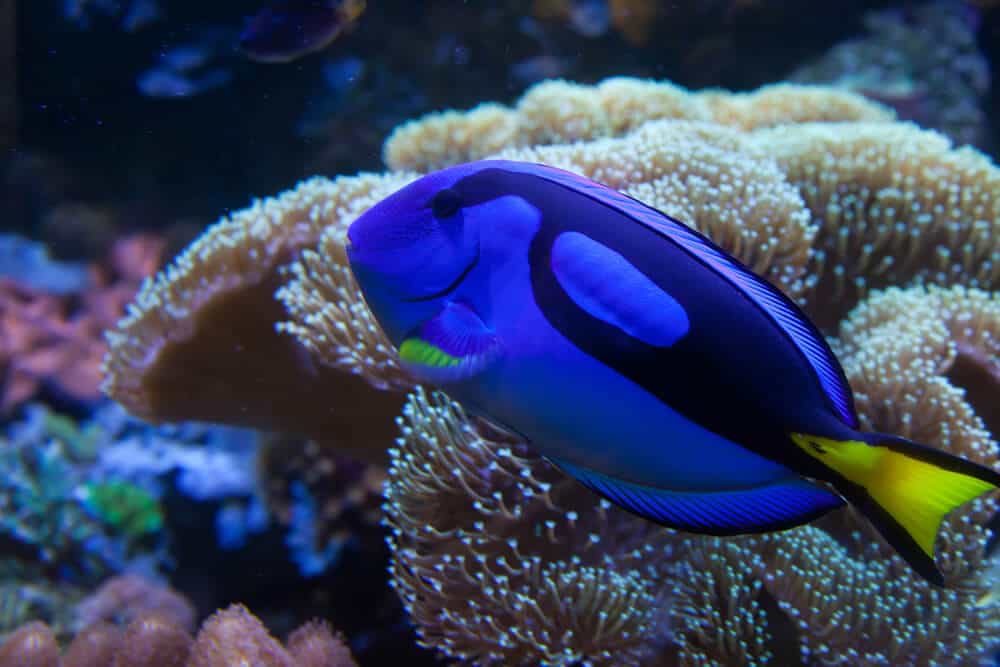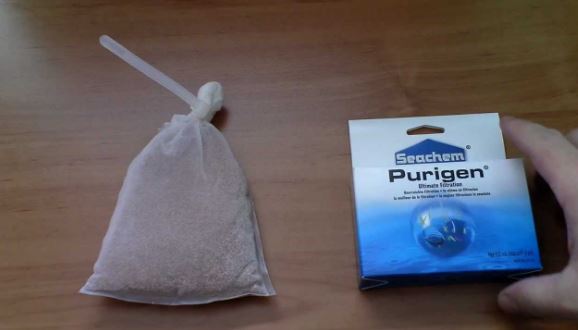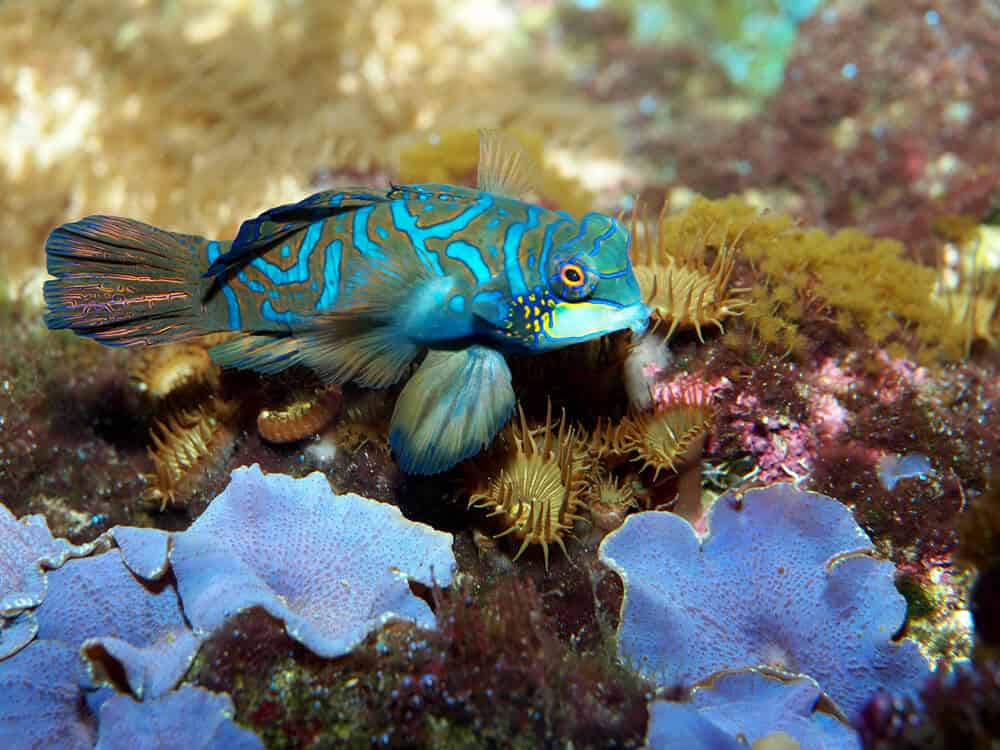
Everyone knows the important role filtration systems play in maintaining attractive and healthy aquariums. Some people successfully maintain their tanks without using filters. However, for most people, owning a filter system will be a tremendous help in maintaining water quality.
However, choosing a suitable filter for aquariums as well as fish tanks is not a simple thing. There are dozens of types of filters on the market. Each type usually has several competing brands and styles. To make choosing more complicated, different accessories and extras are included with some models and not others.
Today, I will introduce you to 9 common filter types, their features, and which type of aquarium they should be used for.
Let’s begin by learning about the roles and requirements for the filtration system in the aquarium.
The Role of Filtration in Fish Tanks and Aquariums
Everyone knows what a filter does, right? Dirty water goes in one side and clean water comes out the other. Simple!

The truth is a little more complicated. I want to help you gain a deeper understanding of what happens in your filter. This knowledge will help you choose the best filter for your tank.
Filter water through filter media
Filters move water through the stuff inside of them. This stuff is called ‘filter media’. There are different kinds of media available. Common varieties include sponges, floss, activated charcoal, filter pads, and more. These all do slightly different things.
However, there are three basic distinctions:
- Mechanical filtration is achieved by filter media that trap physical particles for removal from the tank. An example is when dirt gets caught in a sponge and then removed from the tank when the sponge is changed or cleaned.
- Chemical filtration is done by media such as activated charcoal or purigen. Harmful chemicals and odors bind to the filter pads and are neutralized.
- Biological filtration occurs when water flows over filter media that is covered in bacteria. Bacteria convert poisonous ammonia to harmful nitrite. Nitrite is converted by other bacteria to nitrate, which is less harmful.
These three kinds of filtration are the most common. Good filters achieve all three in a single unit.
Create Flow in the Tank
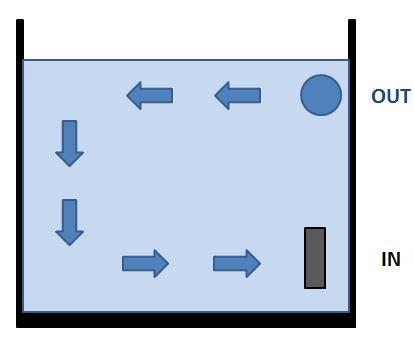
Water should be moving in most tanks. Specialist tanks can be created without pumps or filters, but these are commonly set up for special fish breeds or advanced fish keepers.
Everyone else uses filters to create water flow in their tanks. Water flow is essential for moving nutrients around the tank, preventing chemical build-up in still water, and helping fish stay healthy by making them swim.
Now we’ve covered the basics of filter system requirements. Let’s take a quick tour of the different filters and filtration systems available today.
9 Main Filter Types
#1 – HOB Filter
A Hang-On-Back (HOB) Filter is what it sounds like: a filter that hangs on the back of your tank.

These are great for smaller tanks because they come in smaller sizes. Their lower flow rates are suitable for smaller tanks where high flow rate would damage the plants or fish.
Many of the best models come with three or four types of filter media. Some even have extras such as UV sterilizers.
Pros:
Here are some advantages of HOB filters:
- Suitable for freshwater and saltwater tanks
- One of the easiest filters to clean and maintain
- Very adjustable to suit different tank needs
- Cheap to buy and test
Cons:
These filters can have some drawbacks as well. Here are a few:
- Can be noisy compared to canister filters or internal filters
- Filter media needs regular maintenance and replacement
HOB filters are incredibly common in the aquarium industry. Their frequent use has led to many great designs and upgrades. Major manufacturers such as Fluval and Eheim can be found worldwide. Widespread availability of replacement parts and filter media make maintenance a little less problematic.
Additional content: Check out our guide featuring the best HOB filter on the market.
#2 – Sponge filter
Sponge filters are some of the simplest, cheapest filters on the market. Just like HOB filters, the name is its own description. Sponge filters are simply sponges placed over the intake of a water pump.
They can be very large, small, coarse, fine, or even stacked together to create a more complex system.
There are a few different uses for sponge filters.
- First, they are great for providing gentle filtration necessary for some aquatic animals. Shrimp and Betta fish are great examples of animals needing gentler flow.
- Sponges are also great for filtering water in hospital tanks or special breeder tanks where gentle flow is a must.
- Finally, sponges can act as pre-filters for other filters.
Pros:
Sponge filters have some advantages over other kinds of filters.
- To begin with, they are incredibly simple and cheap to purchase and run.
- Second, maintenance is very easy. Simply keep some of the water from the weekly water change and use it to clean the sponge.
- Finally, sponge filters can be set up in an almost endless variety of configurations.
Cons:
However, there are some disadvantages to sponge filters.
- The most important is the lower amount of filtration media. Sponge filters, while effective, are simply smaller and use less media than an HOB filter, internal filter, or canister filter.
- The second major issue is their size and appearance. Sponge filters are in the tank, so they are highly visible. Careful planting and arrangement can conceal them, though.
#3 – Internal Filter

Most people just beginning to keep fish have seen an internal filter. These black pumps with sponge boxes attached are common accessories to small tanks and starter kits. Companies sell them as adequate filtration systems for smaller tanks.
To be fair, an internal filter can do a great job filtering the water for some tank setups. For example, a glass tank with gravel, ornaments, fake plants, and a few fish might be great for an internal filter. The filtration needs of this tank are probably not going to be very complex.
Pros:
These filters have a few good points, such as:
- They are cheap to buy and run
- Most of them are very quiet because the water muffles any sound
- Many of them have adjustable flow rates and nozzles for improving performance
Cons:
Internal filters can be undesirable for several reasons, though. Here’s a little list:
- The filter is going to be very visible and difficult to hide
- A spray bar may be necessary to control the flow rate for larger tanks
- The filtration quality is limited by the number of filter media spaces, which is usually only one or two sponge boxes
Small, uncomplicated tanks might be fine with an internal filter.
Saltwater tanks are almost always bigger than an internal filter can cope with, so these are usually freshwater filters.
Additional content: Check out our guide featuring the best internal filters on the market.
#4 – Canister Filter
Canister filters are the workhorses of the intermediate and advanced aquarium hobby. These are brilliant for tanks larger than 10 gallons. They are used successfully on tanks up to 400 gallons in size.

There are a few big brands on the market as well as some lesser-known brands offering bargains for those willing to do their research.
Pros:
Canister filters have some huge advantages:
- Their filtration quality is excellent due to large filter media capacity and powerful pumps
- Owners normally hide them away below the tank, so they are not easily visible
- Maintenance is easy in concept – just open the canister and clean everything
Cons:
These advantages come with some problems:
- Canister filters are more costly than other types of filters
- Maintenance is more complicated due to the need to shut off the pump and manage water flow from the tank
Canister filters work for both saltwater and freshwater tanks. Their high output makes them ideal for larger tanks or tanks with a higher bio load of fish and animals.
Additional content: Check out our guide featuring the best canister filters on the market.
#5 – Surface Skimmer
Surface skimmers add a useful capability to a filtration system. They collect debris and oil buildup on the surface of the water and pass it through a filter media pad, usually a sponge or floss arrangement.
Skimming the surface of the tank this way reduces the amount of junk floating in the tank. Doing so then reduces algae growth and promotes better gas exchange at the surface.
Surface skimmers are beneficial in a few ways:
- They are usually attractive and don’t detract from the beauty of the tank
- Surface oil, debris, and even algae are common problems resolved by a surface skimmer
- Most models are small and easily adaptable for small tanks
Of course, there are a few things to consider:
- Surface skimmers tend to be fragile, delicate setups and may require adjustment to function properly
- They are not a complete filtration system and usually require a canister filter’s assistance
I am happy to recommend a couple of these to you.
If you have a small tank, then please consider installing the JARDLI Glass Lily Pipe Inflow with Surface Skimmer for aquarium planted tanks.

This gorgeous unit comes with glass ‘Lily Pipes’ that add beauty and flair to your filtration system. It does need a separate filter or pump to drive the water so this is really an addition to your filtration system rather than a replacement.
If you have a larger tank, then you can use the Odyssea Clean 100 Surface Skimmer.

The Odyssea skimmer works for tanks up to about 60 gallons in size. Its pump moves much more water – up to 110 gallons per hour. This should improve your water circulation as well as provide excellent surface cleaning. However, the powerful pump also uses more energy and takes up more space.
Surface skimmers are great for both freshwater and marine tanks. Both kinds of water will benefit from the extra level of cleaning provided by skimmers.
#6 – Sump Filter
Go big or go home! Some fish keepers seem to make this their motto. Their tanks are massive, their fish are huge, and their filtration systems are impressive. For those interested in truly huge tanks, a sump filter is probably the best option.
Sump filters are extra tanks that function as large filters. They usually sit somewhere under the main tank or behind the tank where they can be hidden from sight.

Sumps are built with several different chambers. Chambers are created by adding glass or acrylic walls inside the spare tank. Different filter media is placed in each chamber. Water is then pumped from the main tank into one end of the sump. The pump pulls clean, filtered water from the other end of the sump and returns it to the tank.
Sumps work very well with both freshwater and marine tanks. The individual components of the sump’s chambers will vary according to the type of filtration needed by each specific tank.
Sumps have some really great features:
- They are totally customizable and can be designed for almost every conceivable tank setup, including both freshwater and saltwater aquariums.
- Sumps provide an extra volume of water to help stabilize the water parameters in the main tank.
- Sumps can also be connected to multiple tanks to provide filtration for a multi-tank room.
- Extra equipment, such as heaters and UV sterilizers, can be hidden away in the sump.
All these benefits come at a cost. Some of the downsides of a sump are:
- Sumps require a large amount of physical space – this is a second fish tank.
- Sump pump failure can result in overflow and mess problems.
- Initial build costs can be much higher than a canister filter.
Despite their downsides, the sump filter is the best choice for anyone installing their dream 300-gallon fish tank/aquarium. I can even recommend a kit for you. Have a look at the Fiji Cube Refugium Sump Baffle Kit.

This kit contains everything you need to convert a common 40-gallon tank to a sump filter. The same company sells different sizes if you are working on a slightly different budget or project.
#7 – Under Gravel Filter
Under gravel filters are not as popular as they once were. Their popularity has waned due to changes in substrate preference. These filters are exactly what their name implies: great filters for gravel.
Under gravel filters work by drawing water down through the tank’s gravel bed and into the filter itself.

The filter sits below the gravel and is made of one, two, or more plates. Each plate has many tiny holes in it to facilitate water movement. The gravel rests on top of the plates and water passes between the rocks to move through the filter below.
Under gravel filters will work in both freshwater and saltwater tanks. However, they require a loose gravel substrate.
Many aquarium tanks use sand as a substrate. Sand is incompatible with an under gravel filter because the sand grains trickle through the filter and clog it. Sand also forms a more solid mass that blocks water passing through to reach the filter.
Filtration designed this way has a huge advantage. The gravel in your tank has a very high surface area for bacterial growth. Think of all those little rocks! Bacteria can grow on every side of every rock. As the powerhead or air stone pushes water through the filter and up the riser tubes, dirty water is drawn down into the gravel. Doing this means the water mixes with all the bacteria in the gravel. This is an excellent biological filter design.
Under gravel filters have some problems, though. The chief issue is circulation. A powerhead or air pump with insufficient power will not move water through every area of the filter. The areas of uncirculated water will become dead zones where harmful bacteria grow. While this can be solved by using a sufficiently powerful pump, these dead zones are a common cause for concern.
I am happy to show you a modern under gravel filter that should work well for anything up to a 50-gallon tank. Please look at the Penn Plax Premium Under Gravel Filter System.

The Penn Plax system comes with multiple plates. Each plate can be cut and shaped to fit fish tanks of different dimensions and footprints. If you’re setting up a simple tank with gravel substrate, this is a great choice for you.
#8 – Wet/dry filter
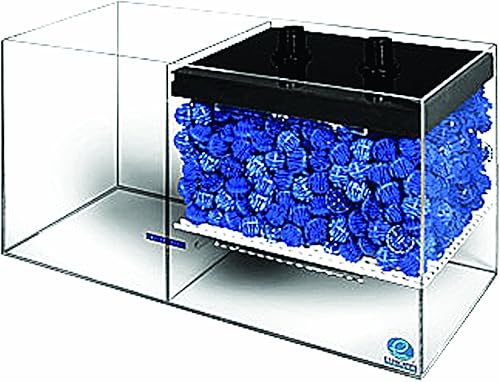
Wet/dry filters are a little confusing to some people. They are, essentially, an addition to a sump system. Their main purpose is to add an extra space for intense biological filtration in a highly aerobic environment. Maybe that’s a lot to take in for one sentence. Here’s how they work:
- Water is pumped from the display/main tank into the top of a wet/dry filter tower.
- A pre-filter, usually a sponge, removes some debris from the water.
- The water passes onto a drip plate. This is a flat plate with many small holes drilled in it.
- Water falls through the holes and picks up lots of oxygen as it moves through the air.
- The falling water lands on biological filtration media where bacteria can begin the ammonia breakdown cycle.
- At the bottom of the biological filter, the water moves into another chamber for extra filtration. Eventually, the water is passed back into the main tank.
Pros:
As you can see, wet/dry filters are additional chambers in a sump system. Because of this, they have some advantages:
- They can provide biological filtration for very large volumes of water. These are the filters for the massive tanks.
- Extra biological filtration can increase the fish capacity of the main tank.
Cons:
They also have some disadvantages. Primarily, they are bulky and can be noisy. The extra vertical space needed to add a tower to a sump filter might make fitting the sump under the main tank difficult.
One note about these filters is their use in saltwater systems. There is some debate in the reef tank community about the usefulness of these filters. Primarily, the biggest filtration difference between a freshwater tank and a saltwater tank is the presence of live rocks and coral in the marine tank. These provide all the biological filtration necessary for most tanks.
Recommended Product:
I can show you one good kit to get you started with your wet/dry filter. Here is the Pro Clear Aquatic Systems Premier Wet/Dry Filter.

It comes with all the gear you need to get up and running (except the pump itself). There is a spray bar, return and siphon hoses, a polishing block, bio balls, and plenty of tubing.
If a large tank is your goal, then this may help you create a clean, fresh, beautiful tank for your fish.
#9 – Protein Skimmer
Our final piece of filtration equipment is another addition to a filter setup. Protein skimmers are used extensively in reef tanks to remove unwanted organic waste from the water.
They work by agitating the water and injecting many micro-bubbles into the water. Through a wonderfully complex process, waste tends to bind to these bubbles. The bubbles carry the waste back to the skimmer where it can be collected and disposed of.
Another name for these devices is ‘foam fractionators’. They do work by creating foam and fracturing the water. Sounds neat, eh?
Protein skimmers are more complex and powerful than their cousins, the Surface Skimmers. Protein skimmers are most useful when they are installed in a sump for a marine tank. There, the most powerful protein skimmers can get to work cleaning the water.
Pros:
The advantage of a protein skimmer is the efficient way it cleans waste from water. These are probably essential equipment for advanced marine tanks with difficult coral.
Cons:
The big disadvantage of a protein skimmer is its price. A good model, designed to go in a sump filter, could sell for several hundred dollars. While this isn’t a big expense considering the budget of many 200+ gallon marine tanks, it is still a considerable sum of money.
Final Thoughts
I’ve tried to show you all the aquarium filter types and systems on the market. Some have probably been missed off my list of fish tank filters. Are you using some equipment I missed? Send me a message and let me know about it.



